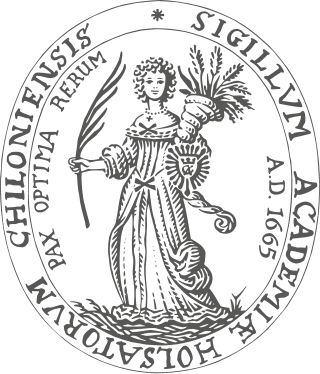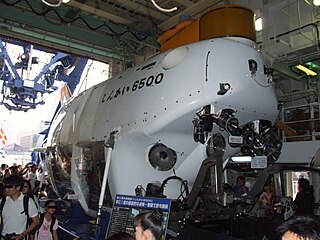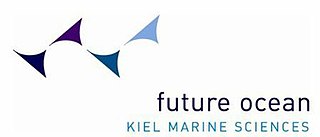
Kiel is the capital and most populous city in the northern German state of Schleswig-Holstein, with a population of 246,243 (2021).

Alvin (DSV-2) is a crewed deep-ocean research submersible owned by the United States Navy and operated by the Woods Hole Oceanographic Institution (WHOI) in Woods Hole, Massachusetts. The vehicle was built by General Mills' Electronics Group in Minneapolis, Minnesota. Named to honor the prime mover and creative inspiration for the vehicle, Allyn Vine, Alvin was commissioned on June 5, 1964. The submersible is launched from the deep submergence support vessel RV Atlantis (AGOR-25), which is also owned by the U.S. Navy and operated by WHOI. The submersible has made more than 5,000 dives, carrying two scientists and a pilot, to observe the lifeforms that must cope with super-pressures and move about in total darkness, as well as exploring the wreck of Titanic. Research conducted by Alvin has been featured in nearly 2,000 scientific papers.

Kiel University, officially the Christian-Albrecht University of Kiel, is a public research university in the city of Kiel, Germany. It was founded in 1665 as the Academia Holsatorum Chiloniensis by Christian Albert, Duke of Holstein-Gottorp and has approximately 27,000 students today. It is the largest, oldest, and most prestigious university in the state of Schleswig-Holstein.
The Helmholtz Association of German Research Centres is the largest scientific organisation in Germany. It is a union of 18 scientific-technical and biological-medical research centers. The official mission of the Association is "solving the grand challenges of science, society and industry". Scientists at Helmholtz therefore focus research on complex systems which affect human life and the environment. The namesake of the association is the German physiologist and physicist Hermann von Helmholtz.

Mir was a class of two self-propelled deep-submergence vehicles. The project was initially developed by the USSR Academy of Sciences along with Lazurit Central Design Bureau, and two vehicles were ordered from Finland. The Mir-1 and Mir-2, delivered in 1987, were designed and built by the Finnish company Rauma-Repola's Oceanics subsidiary. The project was carried out under the supervision of constructors and engineers of the Shirshov Institute of Oceanology.

The Shinkai 6500 (しんかい) is a crewed research submersible that can dive up to a depth of 6,500 metres (21,300 ft). It was completed in 1990. The Shinkai 6500 is owned and run by the Japan Agency for Marine-Earth Science and Technology (JAMSTEC) and it is launched from the support vessel Yokosuka.

Rainer Froese is a senior scientist at the Helmholtz Center for Ocean Research (GEOMAR) in Kiel, formerly the Leibniz Institute of Marine Sciences (IFM-GEOMAR), and a Pew Fellow in Marine Conservation. He obtained an MSc in Biology in 1985 at the University of Kiel and a PhD in Biology in 1990 from the University of Hamburg. Early in his career, he worked at the Institute of Marine Sciences on computer-aided identification systems and the life strategies of fish larvae. His current research interests include fish information systems, marine biodiversity, marine biogeography, and the population dynamics of fisheries and large marine ecosystems.

The GEOMAR - Helmholtz Centre for Ocean Research Kiel (GEOMAR), formerly known as the Leibniz Institute of Marine Sciences, is a research institute in Kiel, Germany. It was formed in 2004 by merging the Institute for Marine Science with the Research Center for Marine Geosciences (GEOMAR) and is co-funded by both federal and provincial governments. It was a member of the Leibniz Association until 2012 and is coordinator of the FishBase Consortium. Since 2012 it is member of the Helmholtz Association and named GEOMAR - Helmholtz Centre for Ocean Research Kiel. The institute operates worldwide in all ocean basins, specialising in climate dynamics, marine ecology and biogeochemistry, and ocean floor dynamics and circulation. GEOMAR offers degree courses in affiliation with the University of Kiel, and operates the Kiel Aquarium and the Lithothek, a repository for split sediment core samples.
The Deutsches Klima-Konsortium e. V. is located in Berlin, Germany, and represents the leading players of German climate and climate impact research encompassing 26 renowned research organisations. The federation is also an important international partner acting as a guidepost, strategic partner, project partner and information broker.

Deepsea Challenger is a 7.3-metre (24 ft) deep-diving submersible designed to reach the bottom of the Challenger Deep, the deepest-known point on Earth. On 26 March 2012, Canadian film director James Cameron piloted the craft to accomplish this goal in the second crewed dive reaching the Challenger Deep. Built in Sydney, Australia, by the research and design company Acheron Project Pty Ltd, Deepsea Challenger includes scientific sampling equipment and high-definition 3-D cameras; it reached the ocean's deepest point after two hours and 36 minutes of descent from the surface.

The Future Ocean is a Cluster of Excellence founded in November 2006 in line with the German excellence initiative by the Christian-Albrechts-Universität zu Kiel (CAU), the Muthesius Kunsthochschule (MKHS), the Institut für Weltwirtschaft (IfW) and the Helmholtz-Zentrum für Ozeanforschung (GEOMAR). It is an interdisciplinary marine research group and it is funded by the German Research Foundation (DFG). Part of the cluster is the Integrated School of Ocean Sciences (ISOS) which is a post graduate school for ocean sciences in Kiel.
Museen am Meer is an association of eight museums in the city centre of Kiel, Schleswig-Holstein, Germany, on the edge of Kiel Fjord. The consortium was founded in 2010.
The ROV KIEL 6000 is a remotely operated vehicle built by Schilling Robotics, Davis, California. It's in the possession of the German GEOMAR - Helmholtz Centre for Ocean Research Kiel. The ROV has been designed for certain scientific tasks with a max. operational depth of 6,000 m. The ROV is electrically powered and directly linked to the operating ship via a deep-sea glass fiber cable. It can be operated from ships of opportunity which fulfill certain requirements such as deck space and stability, power supply, dynamic positioning and crane/winch capacities.
ROV PHOCA is a remotely operated underwater vehicle of the COMANCHE type. It was built by sub-Atlantic, Aberdeen, Scotland and is owned by the GEOMAR - Helmholtz Centre for Ocean Research Kiel. Its smaller size compared to the ROV KIEL 6000 and therefore its deploy ability from medium-sized research vessels makes it a complement to the QUEST type ROV. It can dive up to 3000m and was designed as a Work-Class- and Intervention-ROV.
AUV Abyss is an autonomous underwater vehicle of the REMUS 6000 type and was built in 2008 by Hydroid, LLC (USA). It is owned by the German research facility GEOMAR - Helmholtz Centrum for Ocean Research Kiel. Its name refers to its main working area, the part of the ocean floor between 2000 and 6000 meters called the Abyssal plain. It can be used to map the ocean floor or collect data of the water column. It operates with lithium-ion batteries and can dive up to 22 hours. The AUV can be operated from all large to medium-sized research vessels.
Gerold Siedler is a German physical oceanographer. He is professor emeritus at the Christian-Albrechts University of Kiel and at the GEOMAR Helmholtz Centre for Ocean Research Kiel.
The Institut für Meereskunde in Kiel, Germany, existed from April 1, 1937 to January 1, 2004. It was an essential element of the long history of marine sciences in Kiel. This history started with the work of Samuel Reyher published in 1697 and is today continued within the GEOMAR Helmholtz Centre for Ocean Research Kiel.
Sergey Konstantinovich Gulev is a Russian climate scientist. He is head of the ocean-atmosphere interaction laboratory at the Shirshov Institute of Oceanology, Russian Academy of Sciences and is a professor of oceanology and meteorology at Moscow State University. In 2011, he was elected as a Corresponding Member of the Russian Academy of Sciences.
The International Max Planck Research School for Evolutionary Biology is an international PhD program in Germany dedicated to research and training in Evolutionary Biology. It is one of the top locations in the area of evolutionary and biological research in Germany. It developed as the result of a joint program between the Max Planck Institute for Evolutionary Biology in Plön, the Christian Albrechts University and the Helmholtz Center for Ocean Research (GEOMAR) in Kiel.

The Sea-Watch 4 is a former German research ship. The ship is owned by Sea-Watch e. V. who are using her as a rescue ship for refugees in distress on the Mediterranean Sea. Previously, the GEOMAR Helmholtz Centre for Ocean Research Kiel (GEOMAR) operated the ship under the original name of Poseidon, after the Greek god of the sea, with the State of Schleswig-Holstein as the owner. In January 2020 the ship was auctioned and bought by Sea-Watch e. V. and renamed Sea-Watch 4 on 20 February 2020.










